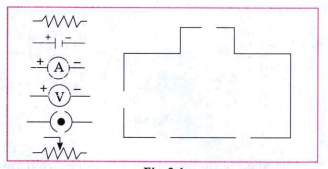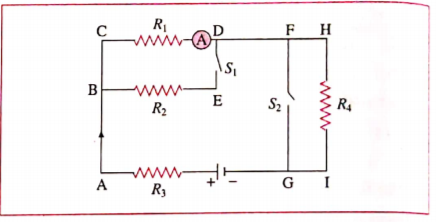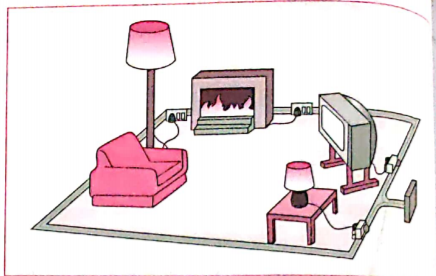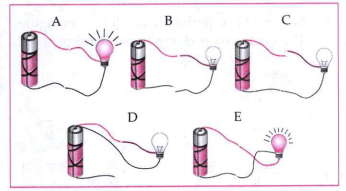Complete Solutions to EXAMPLE of chapter CURRENT ELECTRICITY of Class 9 book with complete answers and questions
| Class 9 | PHYSICS |
| Chapter | CURRENT ELECTRICITY |
| CHETANA PUBLICATION | EXAMPLE |
| Number Of Questions | 94 |
| Academic Year | 2023-24 |
Answer the following question:
You must have seen a waterfull. Which way does the water flow?
View SolutionFind the odd one out:
Voltmeter, Ammeter, Galvanometer, Thermometer
View SolutionFind the odd one out:
Rubber, Silver, Copper, Gold
View SolutionFind the odd one out:
Wood, Glass, Steel, Rubber
View SolutionFind the odd one out:
Graphite, Diamond, Fullerenes, Coal
View SolutionDistinguish between ammeter and voltmeter, (any two points).
View SolutionDistinguish between
Ohmic conductors and Non-Ohmic conductors
View SolutionDistinguish between
Conductors and Insulators
View SolutionMake pair:
Copper : Conductor :: Rubber ……………
View SolutionMake pair:
Aluminium : .... :: Indium oxide : Super Insulator
View SolutionMake pair:
Parallel Connection :`1/R_p=1/R_1+1/R_2`series Connection :……….
View SolutionMake pair:
Electric Current……...Electric charge:Coulomb
View SolutionMake pair:
Electric resistance : Ohm :: Potential difference:………..
View SolutionState whether the following statements are true or false. Correct the false statements:
The SI unit of charge is volt
View SolutionState whether the following statements are true or false. Correct the false statements:
Voltmeter is always connected in series with the device
View SolutionState whether the following statements are true or false. Correct the false statements:
The conventional direction of flow of current is from positive terminal to negative terminal.
View SolutionState whether the following statements are true or false. Correct the false statements:
Silver and copper are good conductors.
View SolutionState whether the following statements are true or false. Correct the false statements:
Resistivity of pure metals is more than alloys.
View SolutionState whether the following statements are true or false. Correct the false statements:
Resistance in series arrangement is used to decrease resistance of circuit
View SolutionState whether the following statements are true or false. Correct the false statements:
A conducting wire offersless resistance to flow of electrons
View SolutionState whether the following statements are true or false. Correct the false statements:
Charges are measured in ampere.
View SolutionState whether the following statements are true or false. Correct the false statements:
The unit of potential difference is ampere
View SolutionState whether the following statements are true or false. Correct the false statements:
Resistance of a conductor is inversely proportional to the length of the conductor.
View SolutionState whether the following statements are true or false. Correct the false statements:
Ammeter is connected in parallel to the cell to measure current.
View SolutionState whether the following statements are true or false. Correct the false statements:
Fuse is made of wire having high melting
View SolutionWhich is the unit used to measure large voltages?
View SolutionWhat is the SI unit of potential difference?
View SolutionWhat is lightning?
View SolutionWhat is the unit of resistivity.
View SolutionWhich substances are called conductors of electricity?
View SolutionWhat is Earth wire?
View SolutionWrite formula:
Electric current
View SolutionWrite formula:
Electric charge
View SolutionWrite formula:
Potential difference
View SolutionWrite formula:
Electric resistance
View SolutionWrite formula:
Current
View SolutionWrite formula:
Resistivity
View SolutionFree electrons are required for conduction of electricity.
View SolutionWood and glass are good insulators.
View SolutionGive scientific reasons:
Connecting wires in a circuit are made of copper and aluminium.
View SolutionA thick wire has a low resistance.
View SolutionA series combination of resistances is used to increase the resistance of a circuit.
View SolutionGive scientific reasons:
Parallel combination of resistances decreases the effective resistance of the circuit.
View SolutionIn street lights, bulbs are connected in parallel.
View SolutionAcurrent of 0.4Aflowsthrough a conductor for 5minutes. How much charge would have passed through the conductor?
View SolutionSolve the following examples (numerical problems):
If a charge of 420 C flows through a conducting wire in 5 minutes what is the value of the current?
View SolutionFind the amount of work done if 3 C of charge is moved through a potential difference of 9 V.
View SolutionThe resistance of the filament of a bulb is `1000 Omega`. It is drawing a current from a source of 230 V. How much current isflowing through it?
View SolutionThe length of a conducting wire is 50 cm and its radius is 0.5 mm. If its resistance is `30 Omega` what is the resistivity of its material?
View SolutionA current of 0.24 A flows through a conductor when a potential difference of 24 V is applied between its two ends. What is its resistance?
View SolutionIf three resistors `15Omega`, `3Omega` and `4 Omega` each are connected in series, what is the effective resistance in the circuit?
View SolutionThree resistances `15Omega` , `20 Omega` and `10 Omega` are connected in parallel. Find the effective resistance of the circui
View SolutionWrite a note on the following:
Electric current
View SolutionWrite a note on the following:
1 ampere
View SolutionWrite a note on the following:
1 volt
View SolutionWrite a note on the following:
Potential Difference
View SolutionWrite a note on the following:
Conductor
View SolutionWrite a note on the following:
Insulators
View SolutionWrite a note on the following:
Lohm
View SolutionWrite a note on the following:
Potential Difference
View SolutionWrite a note on the following:
Ohm's Law
View SolutionWrite a note on the following:
Superconductors
View SolutionWrite a note on the following:
Non-ohmic conductors
View SolutionDistinguish between ammeter and voltmeter.
View SolutionDistinguish between ammeter and voltmeter, (any two points).
View SolutionDistinguish between
Conductors and Insulators
View SolutionDistinguish between:
Resistance and Resistivit
View SolutionDistinguish between resistance in series and resistance in parallel.
View SolutionWrite properties / characteristics / advantages of following
Superconductors
View SolutionSafety precautions are to be taken while using electricity.
View SolutionFuse used in electrical circuit can save electrical objects from damage.
View SolutionBulbs arranged in parallel glow brighter than bulbs arranged in series
View SolutionThe length of a conducting wire is 50 cm and its radius is 0.5 mm. If its resistance is `30 Omega` what is the resistivity of its material?
View SolutionDetermine the current that will flow when a potential difference of 33 V is applied between two ends of an appliance having a resistance of `110Omega`. If the same current is to flow through an appliance having a resistance of `500Omega`, how much potential difference should be applied across its two ends?
View SolutionDetermine the resistance of a copper wire having a length of 1 km and diameter of 0.5 mm
View SolutionThe resistance of a 1m long nichrome wire is `6 Omega`. If we reduce the length of the wire to 70 cm, what will its resistance be?
View SolutionSolve:
Two resistors having resistance of 16 and 14 are connected in series, if a potential difference of 18 V is applied across them, calculate the current flowing through the circuit and the potential difference across each individual resistor
View SolutionIf the resistors `5Omega`,`10Omega`and `30Omega`are connected in parallel to battery of 12 V, find the effective resistance in the circuit. Calculate the total current and current in each resistor.
View SolutionWhen two resistors are connected in seriesthe total resistance is `80Omega` and if the same resistors are connected in parallel the total resistance becomes `20Omega`.Find the individual resistors.
View SolutionThe following figure shows the symbols for components used in the accompanying electrical circuit.

Place them at proper places and complete the circuit
Which law can you proves with the helpof the above cirrcuit?
State expression of Ohm's law.
View SolutionResistances `R_1, R_2, R_3 and R_4`, are connected as shown in the figure. `S_1` and `S_2` are two keys. Discuss the current flowing in the circuit in the following cases.
` S_1` is closed but `S_2` is open.

View SolutionExplain with the help of a diagram, what are free electrons andhow they move through the conductor?

View SolutionMaterial: Copper and aluminium wires, glass rod,rubber. Make connection as shown in figure 3.8. First connect a copper wire betweenpoints A and B and measure the currentinthe circuit.Thenin place of the copper wire, connect aluminium wire, glass rod, rubber, etc one at a time and measure the current each time. Compare the values of the current in different cases

View SolutionIf resistors are connected in series.
View SolutionAnswer the following question:
Obtain an expression for the effective resistance when a number of resistors are connected in parallel.
View SolutionAnswer the following question:
The accompanying figure shows some electrical appliances connected in a circuit in a house.

What must be the potential difference across individual appliances?
View SolutionAnswer the following question:
The accompanying figure shows some electrical appliances connected in a circuit in a house.

why are the domestic appliances connected in this way?
View SolutionIf the T.V. stops working, will the other appliances also stop working? Explain your answer.
View SolutionDoes the water stop flowing ?why?
View SolutionWhat will you do to keep the water flowing for a longer duration?
View SolutionPoint out the mistakes in the figure below:

View SolutionWhy are the bulbs in Figures B, C and D not lighting up?

View SolutionWhy should a person wear footwear with rubber soles while handling electrical appliances.
View SolutionSaee is touching an electricla button socket with wet hands what will you advise her and why?
View Solution
EXAMPLE questions and complete solutions for chapter CURRENT ELECTRICITY of CHETANA PUBLICATION of Class 9